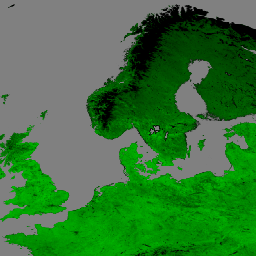
- Disponibilidade de conjuntos de dados
- 2012-01-17T00:00:00Z–2025-12-11T00:00:00Z
- Provedor de conjunto de dados
- NASA LP DAAC no USGS EROS Center
- Cadência
- 8 dias
- Tags
Descrição
O produto de dados de índices de vegetação (VNP13A1) do Visible Infrared Imaging Radiometer Suite (VIIRS) da NASA (Suomi National Polar-Orbiting Partnership, S-NPP) fornece índices de vegetação por um processo de seleção do melhor pixel disponível em um período de aquisição de 16 dias com resolução de 500 metros. Os produtos de dados VNP13 foram projetados com base na suíte de produtos de índices de vegetação Terra e Aqua do Moderate Resolution Imaging Spectroradiometer (MODIS) para promover a continuidade da missão do Earth Observation System (EOS).
O processo do algoritmo VNP13 produz três índices de vegetação: (1) Índice de Vegetação por Diferença Normalizada (NDVI), (2) Índice de Vegetação Aprimorado (EVI) e (3) Índice de Vegetação Aprimorado-2 (EVI2). (1) O NDVI é uma das séries temporais contínuas mais longas de observações de sensoriamento remoto, usando as bandas vermelha e infravermelha próxima (NIR). (2) O EVI é um índice de vegetação ligeiramente diferente, mais sensível à cobertura da copa, enquanto o NDVI é mais sensível à clorofila. (3) O EVI2 é uma reformulação do EVI padrão de três bandas, usando as bandas vermelha e NIR. Essa reformulação aborda problemas que surgem ao comparar o EVI do VIIRS com outros modelos de EVI que não incluem uma banda azul. O EVI2 vai se tornar o EVI padrão.
Além das três camadas de índices de vegetação, esse produto também inclui camadas de refletância no infravermelho próximo (NIR), três refletâncias no infravermelho de ondas curtas (SWIR) (vermelha, azul e verde), dia do ano composto, confiabilidade de pixel, ângulos de visualização e de sol, além de uma camada de qualidade.
Para mais informações, acesse o site de avaliação da qualidade de produtos terrestres (link em inglês) do VIIRS e consulte o guia do usuário (link em inglês).
Documentação:
Bandas
Tamanho do pixel
500 metros
Bandas
| Nome | Unidades | Tamanho do pixel | Comprimento de onda | Descrição | |||||||||||||||||||||||||||||||||||||||||||||||||||||||||||||||||||||||||||||||||||||||||||||||
|---|---|---|---|---|---|---|---|---|---|---|---|---|---|---|---|---|---|---|---|---|---|---|---|---|---|---|---|---|---|---|---|---|---|---|---|---|---|---|---|---|---|---|---|---|---|---|---|---|---|---|---|---|---|---|---|---|---|---|---|---|---|---|---|---|---|---|---|---|---|---|---|---|---|---|---|---|---|---|---|---|---|---|---|---|---|---|---|---|---|---|---|---|---|---|---|---|---|---|---|
EVI |
metros | Nenhum | Índice de vegetação aprimorado de três bandas |
||||||||||||||||||||||||||||||||||||||||||||||||||||||||||||||||||||||||||||||||||||||||||||||||
EVI2 |
metros | Nenhum | Índice de vegetação aprimorado de duas bandas |
||||||||||||||||||||||||||||||||||||||||||||||||||||||||||||||||||||||||||||||||||||||||||||||||
NDVI |
metros | Nenhum | Índice de vegetação por diferença normalizada |
||||||||||||||||||||||||||||||||||||||||||||||||||||||||||||||||||||||||||||||||||||||||||||||||
NIR_reflectance |
metros | 846 a 885 nm | Refletância de radiação infravermelha próxima |
||||||||||||||||||||||||||||||||||||||||||||||||||||||||||||||||||||||||||||||||||||||||||||||||
SWIR1_reflectance |
metros | 1230 a 1250 nm | Reflectância de radiação infravermelha de ondas curtas |
||||||||||||||||||||||||||||||||||||||||||||||||||||||||||||||||||||||||||||||||||||||||||||||||
SWIR2_reflectance |
metros | 1580 a 1640 nm | Reflectância de radiação infravermelha de ondas curtas |
||||||||||||||||||||||||||||||||||||||||||||||||||||||||||||||||||||||||||||||||||||||||||||||||
SWIR3_reflectance |
metros | 2225 a 2275 nm | Reflectância de radiação infravermelha de ondas curtas |
||||||||||||||||||||||||||||||||||||||||||||||||||||||||||||||||||||||||||||||||||||||||||||||||
VI_Quality |
metros | Nenhum | Campo de bits de avaliação de qualidade (QA, na sigla em inglês). |
||||||||||||||||||||||||||||||||||||||||||||||||||||||||||||||||||||||||||||||||||||||||||||||||
red_reflectance |
metros | 600 a 680 nm | Reflectância da banda vermelha |
||||||||||||||||||||||||||||||||||||||||||||||||||||||||||||||||||||||||||||||||||||||||||||||||
green_reflectance |
metros | 545 a 656 nm | Refletância da banda verde |
||||||||||||||||||||||||||||||||||||||||||||||||||||||||||||||||||||||||||||||||||||||||||||||||
blue_reflectance |
metros | 478 a 498 nm | Reflectância da banda azul |
||||||||||||||||||||||||||||||||||||||||||||||||||||||||||||||||||||||||||||||||||||||||||||||||
composite_day_of_the_year |
d | metros | Nenhum | Dia juliano do ano |
|||||||||||||||||||||||||||||||||||||||||||||||||||||||||||||||||||||||||||||||||||||||||||||||
pixel_reliability |
metros | Nenhum | Utilidade do Pixel usando uma classe de classificação simples |
||||||||||||||||||||||||||||||||||||||||||||||||||||||||||||||||||||||||||||||||||||||||||||||||
relative_azimuth_angle |
graus | metros | Nenhum | Ângulo de azimute relativo para cada pixel |
|||||||||||||||||||||||||||||||||||||||||||||||||||||||||||||||||||||||||||||||||||||||||||||||
sun_zenith_angle |
graus | metros | Nenhum | Ângulo de azimute solar para cada pixel |
|||||||||||||||||||||||||||||||||||||||||||||||||||||||||||||||||||||||||||||||||||||||||||||||
view_zenith_angle |
graus | metros | Nenhum | Ver o ângulo zenital de cada pixel |
|||||||||||||||||||||||||||||||||||||||||||||||||||||||||||||||||||||||||||||||||||||||||||||||
Tabela de classes pixel_reliability
| Valor | Cor | Descrição |
|---|---|---|
| 0 | Nenhum | Excelente |
| 1 | Nenhum | Boa |
| 2 | Nenhum | Aceitável |
| 3 | Nenhum | Marginal |
| 4 | Nenhum | Aprovado |
| 5 | Nenhum | Questionável |
| 6 | Nenhum | Ruim |
| 7 | Nenhum | Sombra de nuvem |
| 8 | Nenhum | Neve/gelo |
| 9 | Nenhum | Cloud |
| 10 | Nenhum | Estimativa |
| 11 | Nenhum | LTAVG (extraído do banco de dados) |
Termos de Uso
Termos de Uso
Os dados da NASA do LP DAAC são de livre acesso. No entanto, quando um autor publica esses dados ou trabalhos baseados neles, é necessário citar os conjuntos de dados no texto da publicação e incluir uma referência a eles na lista de referências.
Citações
Acesse a página "Como citar nossos dados" do LP DAAC para informações sobre como citar conjuntos de dados do LP DAAC.
DOIs
Explore com o Earth Engine
Editor de código (JavaScript)
var dataset = ee.ImageCollection('NASA/VIIRS/002/VNP13A1') .filter(ee.Filter.date('2017-05-01', '2017-06-30')); var rgb = dataset.select(['EVI']); var rgbVis = { min: 0.0, max: 1.0, palette: ['000000', '004400', '008800', '00bb00', '00ff00'], }; Map.setCenter(17.93, 7.71, 6); Map.addLayer(rgb, rgbVis, 'RGB');
